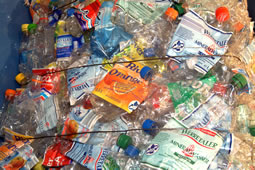The Fraunhofer Institute for Chemical Technology ICT in Pfinztal-Berghausen near Karlsruhe (Southern Germany) has developed and tested a process to prepare mixed PET (polyethylene terephthalate) from sorted packaging waste for mechanical recycling. The material can be used for injection moulded parts in technical applications.
 (01.06.2010) In Germany, 400,000 tons of PET was consumed in 2004, 385,000 tons of this (more than 96 per cent) was used for packaging. Consumption of PET packaging is growing at double-digit percentage rates. At the same time mixtures or barrier layers cause discoloration and other changes that make reuse difficult. The recorded amount of PET provided for recycling in Germany is in excess of 200,000 tons per annum. PET recycling has been state-of-the-art for many years. The collected material flows of PET are used mainly to produce polyester fibres, sheets for thermoforming, strapping tape or new bottles.
(01.06.2010) In Germany, 400,000 tons of PET was consumed in 2004, 385,000 tons of this (more than 96 per cent) was used for packaging. Consumption of PET packaging is growing at double-digit percentage rates. At the same time mixtures or barrier layers cause discoloration and other changes that make reuse difficult. The recorded amount of PET provided for recycling in Germany is in excess of 200,000 tons per annum. PET recycling has been state-of-the-art for many years. The collected material flows of PET are used mainly to produce polyester fibres, sheets for thermoforming, strapping tape or new bottles. | Copyright: | © Deutscher Fachverlag (DFV) |
| Quelle: | Entsorga China 01_2010 (Juni 2010) |
| Seiten: | 1 |
| Preis: | € 0,00 |
| Autor: | Prof. Dr.-Ing. Jörg Woidasky Dipl.-Ing. Andreas Stolzenberg |
| Artikel nach Login kostenfrei anzeigen | |
| Artikel weiterempfehlen | |
| Artikel nach Login kommentieren | |
Stand der Pumpspeicher in Deutschland 2025
© Springer Vieweg | Springer Fachmedien Wiesbaden GmbH (12/2025)
Infolge des Ausbaus der Stromerzeugung aus erneuerbaren Energien ist ein erhöhter Speicherbedarf im Stromverbundnetz notwendig. Hierdurch steigt die Bedeutung von Pumpspeichern als bis auf weiteres einzige Möglichkeit für eine großmaßstäbliche Stromspeicherung.
Pumpspeicherkraftwerke - Empfehlungen zur Verkuerzung und Vereinfachung von Genehmigungsverfahren in Deutschland
© Springer Vieweg | Springer Fachmedien Wiesbaden GmbH (12/2025)
Die Genehmigungsverfahren sind sehr komplex sowie mit hohen Kosten und rechtlichen Unsicherheiten verbunden und dauern oftmals mehr als zehn Jahre.
Revitalisierung des Pumpspeicherwerks Happurg - Sanierung des Oberbeckens
© Springer Vieweg | Springer Fachmedien Wiesbaden GmbH (12/2025)
Im Rahmen der Revitalisierung des Pumpspeicherwerks Happurg haben im September 2024 auch die Arbeiten zur Sanierung des zugehörigen Oberbeckens begonnen.